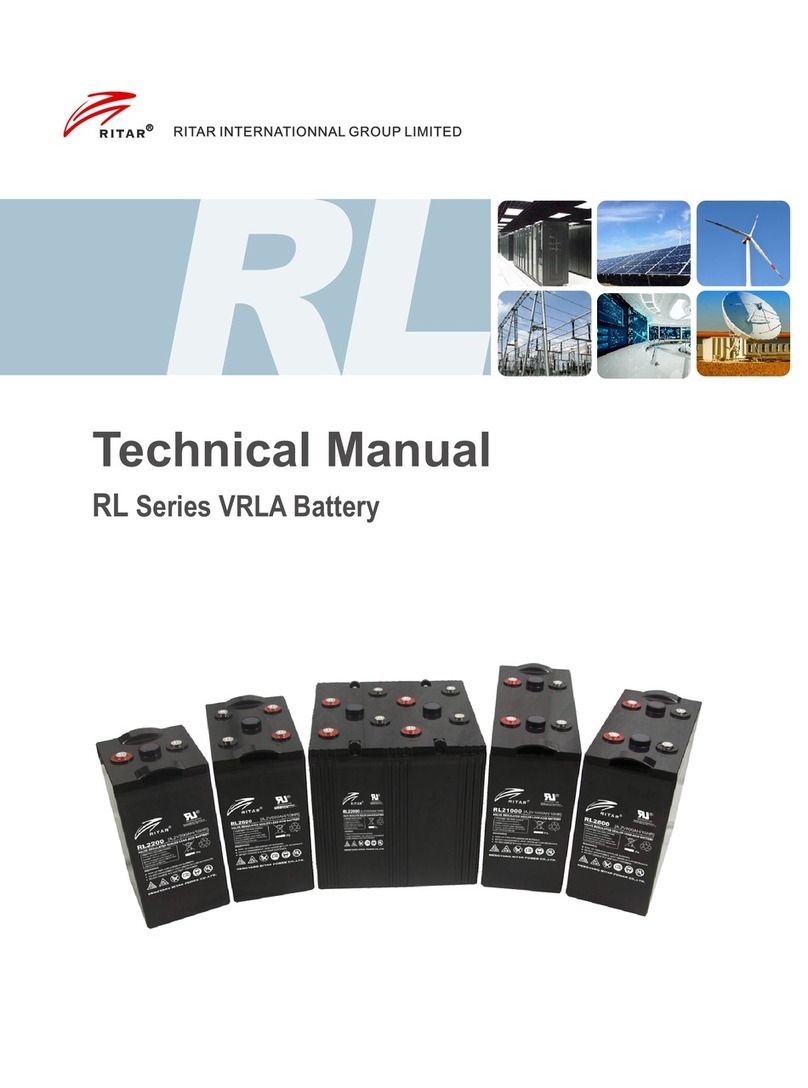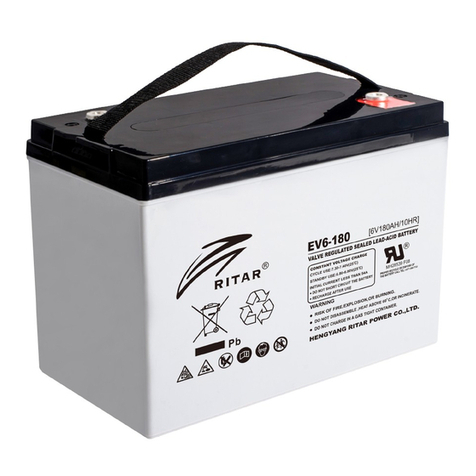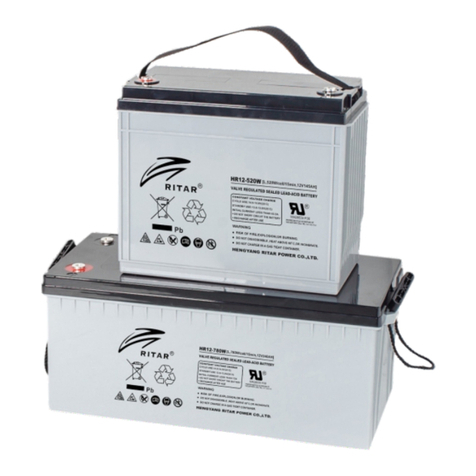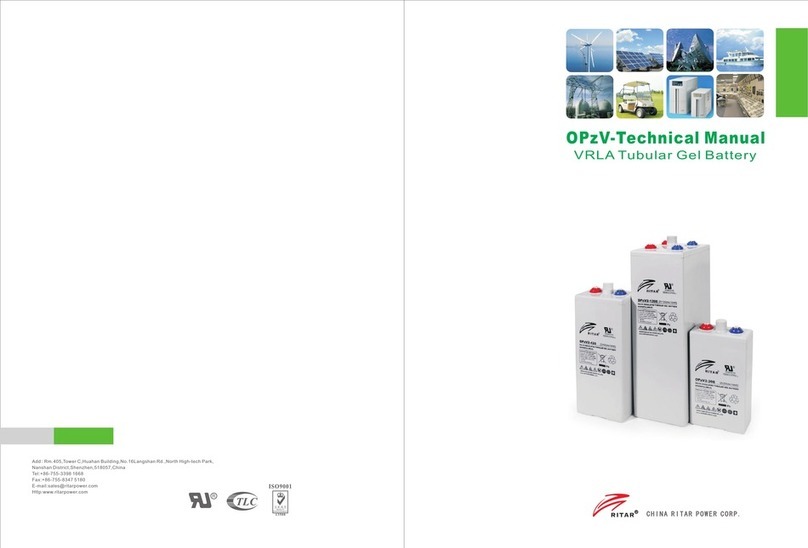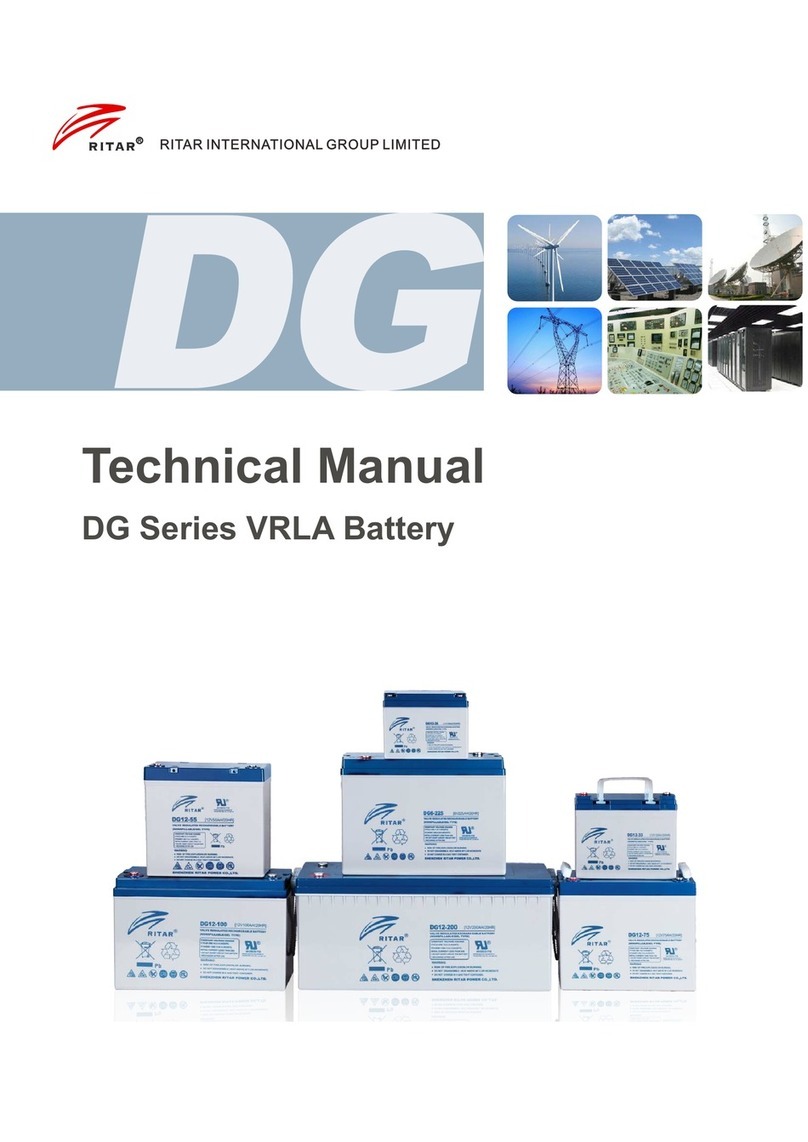
0.04
0.08
0.12
0.16
0.20
0.24
0.28
Charge Characteristic Curve of Float Use
Charge Volume (%)
Charge Current (A)
Charge Voltage (V)
Charge Time (Hr)
Charge Voltage
Charge Volume
Discharge
Charge with
& Limited Current :
Charge Voltage: 2.30V/Cell
Charge Current: 0.2
Constant Voltage
C A
10
Temperature: 25℃/77℉
2.60
2.40
2.20
2.0
1.8
1.6
2.42
2.36
0.30
0.24
0.18
0.12
0.06
Charge Characteristic Curve of Cycle Use
Charge Volume (%)
Charge Current (A)
Charge Voltage (V)
Charge Voltage
Charge Volume
Discharge
Charge with
& Limited Current :
Charge Voltage: 2.40V/Cell
Charge Current: 0.2
Constant Voltage
C A
10
Temperature: 25℃/77℉
Charge Time (Hr)
Storage Time (Month)Charge Voltage (V/Cell)Maximum Charge Current(A)
Maximum Charge Time(Hr)
3
~
6
6
~
12
2.40
2.40
0.2C 10
0.2C 10
24
36
Storage Time vs Charge Voltage and Charge Time
Battery Charge, Discharge & Life
Remaining Capacity (%)
Capacity Reservation Curves
No need of supplementary
charging. Used in float
charge.
Supplementary Charging
is required.
Supplementary Charging
performance will be affected.
It is prohibited to leave
the battery standing
till this state.
Storage Time (Month)
More information please contact us at +86 755-3398 1668 http://www.ritarpower.com
1. Charge Characteristics
Charge condition is one of the important factors in battery use.
The battery performance and service life are directly related to
its charging methods and charging parameters in using.
The battery is recommended to be charged at the temperature range
of 5-30℃.At any temperature lower than 5℃ or higher than 35℃
it will cause undercharge or overheating and then decrease the
battery life.
2. Charge Curve of Float Use
3. Relationship between Float Charge Voltage and Environment Temperature
At general temperature (5℃~30℃), float charge voltage is 2.25V~2.30V. The batteries for float charge service
adopt the constant voltage but limited current method. The initial current is 0.1C A and the maximum current is 0.2 .
10
1) At 25℃, the float charge voltage of battery is 2.27V per cell.
2) When the ambient temperature changes, the float charge voltage should be adjusted. The temperature compensation
coefficient is -3Mv/, i.e., Ufloat =「2.27 – 0.003(t-25)」* n.
4. Equalize Charge
Equalize charge is required for float service as long time float charge will make some batteries drop behind in the battery
bank. An equalize charge can prevent battery stratification and reduce sulfation, which is the leading cause of battery
failure, and bring all cells to similar levels.
Equalize charge requirements for RITAR battery as follows:
※ Equalize charge 1 time every three months or every 20 discharge cycles.
※ Equalize charge method: with equalize charge voltage 2.35~2.45Vpc @25℃ and max. charge current 0.3CA, and
equalize charge time is 12~24h(when the charge current at the end stable about 2~3 hours, stopped equalize and switch
to float ).
※ Before equalize charge please let the battery 100% discharged.
5. Charge Curve of Cycle Use
The batteries for cycle service adopt the constant voltage but limited
current method. At 20℃~25℃, the charge voltage of battery is 2.40V
per cell; the initial charge current is not larger than 0.2C A and the
10
battery fully charges in approximately 24 hours.
Charge curves are as right.
6. Supplementary Charge
C A
10
www.ritarpower.com
Due to self-discharge, the battery capacity reduces slowly in long
time storage. A supplementary charge is required prior to
installation. For the relationship of capacity, temperature and
storage time, please see the right curve figure. Apply supplementary
charge with constant voltage but limited current: charging current is
0.05C -0.2C ; charging voltage is 2.35±0.05V/Cell; charge time is
10 10
24~36 hours.






